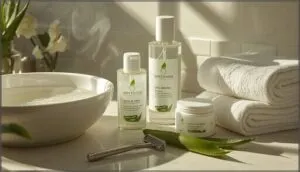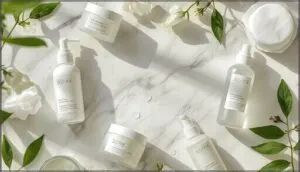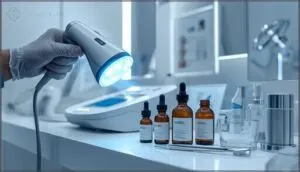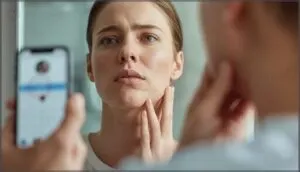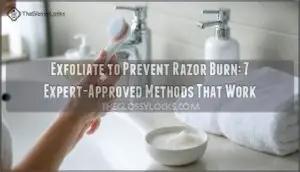This site is supported by our readers. We may earn a commission, at no cost to you, if you purchase through links.

Razor bumps don’t discriminate, but they do play favorites—and sensitive skin often takes the worst hit. When your hair curves back into the skin after shaving, it triggers inflammation that can leave you dealing with painful red bumps, persistent itching, and dark spots that linger long after the irritation fades. For people with naturally curved hair follicles or reactive skin, this cycle becomes frustratingly predictable.
The good news is that razor bumps aren’t something you have to accept as inevitable. With the right combination of prevention tactics, gentle home remedies, and targeted treatments, you can break free from the shave-and-suffer routine and finally achieve smooth, comfortable skin.
Table Of Contents
Key Takeaways
- Razor bumps happen when shaved hair curls back into your skin, causing inflammation that’s especially problematic for people with curly or coarse hair—affecting up to 65% of those with naturally curved follicles.
- Prevention works better than treatment: shave with the grain using sharp blades, prep your skin properly with warm water and exfoliation, and choose single-blade or electric razors to cut irritation by 40% or more.
- Home remedies like aloe vera, salicylic acid exfoliation, and tea tree oil can reduce inflammation significantly, but you’ll need prescription treatments or laser hair removal if bumps persist beyond two weeks or show signs of infection.
- Darker skin tones face higher risks of permanent scarring and hyperpigmentation from razor bumps, making gentle techniques and early intervention crucial for avoiding lasting damage.
What Causes Razor Bumps on Sensitive Skin
Razor bumps happen when shaved hair curls back and grows into your skin instead of rising straight up. This creates inflammation, redness, and those frustrating bumps that can linger for days or even weeks.
Understanding what triggers this reaction—especially on sensitive skin—helps you take the right steps to prevent and treat it.
Ingrown Hairs and Curly Hair
When you have curly or coarse hair, your curl pattern makes ingrown hairs far more likely. The hair grows back into your skin rather than outward, triggering skin irritation and inflammation.
Studies show that up to 65% of people with curly hair develop razor bumps—also called folliculitis barbae. This mechanical cause creates those painful, red bumps you’ve probably experienced after shaving. This is because hair can grow inward, especially after hair removal.
Common Risk Factors
Beyond hair characteristics, several razor bump risk factors increase your chances of developing this frustrating condition.
- Skin sensitivity: Your skin’s reactivity to friction and shaving makes irritation more likely
- Shaving practices: Dull razors, multi-blade razors, and shaving against the grain cut hair below skin level
- Genetic factors: Men of African descent face 45% to 83% razor bump rates due to naturally curved follicles
- Environmental factors: Tight clothing and harsh products worsen inflammation after hair removal
These bumps occur when curly hairs get trapped inside the follicle.
Symptoms Specific to Sensitive Skin
Sensitive skin reacts more dramatically than other skin types after shaving. You’ll notice pronounced redness and inflammation around the bumps, often with persistent itching and discomfort that lasts beyond typical irritation.
Skin dryness frequently accompanies these symptoms, making the area feel tight and flaky. Over time, hyperpigmentation and dark spots develop where inflammation occurs—especially troublesome in darker skin tones.
Your skin’s delayed healing means bumps stick around longer than you’d like.
Effective Prevention Strategies
The best way to deal with razor bumps is to stop them before they start. Prevention doesn’t require expensive products or complicated routines—it’s about making smarter choices at every step of your hair removal process.
Let’s look at the key strategies that can keep your sensitive skin smooth and bump-free.
Pre-Shave Skin Preparation
Think of pre-shave preparation as building a protective shield for your skin. Proper preshaving preparation helps maintain skin pH balance and reduces irritation by up to 70%.
- Cleanse thoroughly with a pH-balanced wash to remove oils and debris before shaving
- Exfoliate gently 24 hours prior to lift ingrown hairs and prevent clogged follicles
- Soften hair with a warm towel for 2-3 minutes to open pores
- Layer protective products like pre-shave oils for enhanced glide and hydration
Routine consistency in your skin care regimen makes all the difference for sensitive skin.
Choosing The Right Shaving Tools
The razor you choose can make or break your shaving experience. Safety razors cause less skin redness than cartridge models—40% versus nearly 58% immediately after use. Electric shavers with foil heads reduce bumps by limiting passes over your skin.
Sharp blades matter too because dull ones tug and irritate. Handle design affects control, while proper razor maintenance—replacing blades every 3-5 shaves—keeps irritation at bay.
Shaving Techniques to Minimize Irritation
With proper technique, you can reduce razor bumps dramatically. Always shave with the grain—against it increases irritation by 35% in curly-haired individuals. Apply light blade pressure and limit stroke frequency; each additional pass raises redness risk by 15%.
Use quality lubrication to decrease irritation by 40%. After shaving, rinse with cold water and apply fragrance-free moisturizer for best skin care after shaving.
Alternative Hair Removal Methods
If shaving consistently causes problems, consider alternative hair removal methods that work better for sensitive skin.
Sugaring benefits include natural ingredients and reduced ingrown hairs since it removes hair with growth direction. Threading precision makes it ideal for facial areas, while laser safety depends on choosing Nd:YAG or diode lasers.
However, waxing risks include folliculitis, and cream drawbacks involve chemical irritation. Electrolysis offers permanent results but requires multiple sessions.
Home Remedies for Razor Bumps
When razor bumps appear, you don’t always need to reach for prescription treatments right away. Several gentle, accessible remedies can calm irritation and help free trapped hairs without adding more stress to your sensitive skin.
Let’s walk through some practical approaches you can try at home to ease discomfort and support your skin’s natural healing process.
Gentle Exfoliation Methods
Exfoliation clears away dead cells that trap hairs beneath your skin’s surface. For sensitive skin, gentle exfoliation once or twice weekly helps free ingrown hairs without causing further irritation.
Choose your approach carefully:
- Chemical exfoliants like salicylic acid or glycolic acid dissolve blockages and reduce bump formation by up to 52%
- Mechanical options with ultra-fine, round grains minimize microtears better than harsh scrubs
- Apply a warm washcloth first to soften skin before exfoliating
- Frequency guidelines recommend limiting to once weekly initially for highly reactive skin
- Product safety matters—select fragrance-free formulas without plastic microbeads
Soothing Natural Ingredients
Nature offers several proven remedies that calm irritated skin without harsh chemicals. Aloe vera accelerates healing—studies show it reduced inflammation in 93% of wound cases. Tea tree oil fights bacteria while loosening trapped hairs when properly diluted. Colloidal oatmeal baths decrease irritation within 48 hours.
Natural remedies like aloe vera, tea tree oil, and colloidal oatmeal effectively soothe razor bumps without harsh chemicals
Chamomile and witch hazel deliver anti-inflammatory benefits, with witch hazel reducing swelling in 68% of users within a day.
Moisturizing and Aftercare Tips
Your skin needs consistent support after every shave—that’s where hydration importance and blade hygiene converge. Moisturize immediately with an alcohol-free aftershave balm to lock in protection.
Follow these derm protocols daily:
- Rinse thoroughly with warm water to remove residue.
- Apply aloe or hydrocortisone cream on inflamed areas.
- Choose fragrance-free aftercare products to prevent stinging.
- Moisturize again at night for barrier repair.
- Replace blades every 5–7 shaves.
Avoiding Common Irritants
While you’re building that protective skin barrier with daily moisturizing, watch what you put on it. Fragrance-free products and alcohol alternatives prevent the stinging that worsens skin irritation after shaving.
Choose hypoallergenic options with gentle surfactants instead of harsh soaps. If you have preservative sensitivity, noncomedogenic products won’t clog pores or trigger inflammation—your skin care for sensitive skin should heal, not harm.
Medical and Professional Treatment Options
When home remedies aren’t enough to clear your razor bumps, professional treatments can offer more targeted relief. Your dermatologist has access to stronger medications and procedures that address both the inflammation and the underlying hair growth patterns.
Let’s look at the medical options that work best for sensitive skin.
Topical Treatments for Sensitive Skin
When skin irritation after shaving strikes, topical treatment can help. Hydrocortisone cream reduces inflammation quickly, though steroid side effects require limiting use to about three days. Retinoid tolerance varies—adapalene suits sensitive skin better than tretinoin.
Acid exfoliation with salicylic or glycolic acid clears follicles effectively. Antibiotic resistance concerns make benzoyl peroxide combinations preferable.
Moisturizer benefits include reduced dryness; aloe vera gel and diluted tea tree oil provide natural relief.
Prescription Solutions and Procedures
When over-the-counter options fall short, your doctor can prescribe stronger tools. Oral antibiotics like minocycline (50-100 mg twice daily) tackle infection, while corticosteroid injections shrink stubborn inflammation by 70% within weeks. Eflornithine cream slows regrowth by up to 70%, and laser therapy reduces bumps over 75% after three sessions.
- Prescription-strength treatments target resistant cases
- Topical steroids and retinoids work faster than drugstore versions
- A board-certified dermatologist tailors combination therapies to your skin
Permanent Hair Removal Considerations
If repeat treatments feel exhausting, permanent hair removal methods offer freedom. Laser hair removal delivers a 75–90% reduction after six to eight sessions, though touch-ups help maintain results. Electrolysis options permanently destroy follicles but take longer. Cost analysis matters—sessions run $20–$510 depending on the area. Long-term effects favor darker, coarser hair on lighter skin. Skin sensitivity demands Nd:YAG or diode lasers with cooling to minimize side effects like hyperpigmentation or burns.
| Method | Efficacy | Best For |
|---|---|---|
| Nd:YAG Laser | 30–73% reduction | Darker skin types |
| Alexandrite Laser | 35–84% reduction | Lighter skin, dark hair |
| Diode Laser | 32–69% reduction | Sensitive skin |
| IPL | 27–53% reduction | Light hair concerns |
| Electrolysis | Permanent removal | All hair/skin types |
Treating Infected or Severe Razor Bumps
When infection takes hold, you need medical treatment fast. Topical antibiotics like clindamycin or mupirocin clear localized bacteria, while oral antibiotics tackle deeper tissue involvement—resolving symptoms in 80–85% of cases within two weeks.
Your board-certified dermatologist may recommend drainage for abscesses, hydrocortisone to calm inflammation, or systemic therapies for stubborn lesions.
Proper wound care and scarring prevention with retinoids or silicone gel keep your skin from lasting damage.
When to Seek Medical Advice
Most razor bumps clear up on their own with basic home care, but sometimes your skin needs professional attention. Knowing when to reach out to a dermatologist can prevent complications and save you weeks of discomfort.
Let’s look at the warning signs that mean it’s time to schedule an appointment.
Signs of Infection or Complications
Most razor bumps heal on their own, but watch for warning signs that signal trouble. Pustule formation, spreading redness beyond the bump site, and persistent swelling suggest infection requiring antibiotics.
If you notice increasing warmth, fever, or systemic symptoms, seek care immediately. Untreated infections raise your risk of scarring and keloid scars—complications a board-certified dermatologist can help you avoid.
Persistent or Worsening Symptoms
When razor bumps linger beyond two weeks or worsen despite home care, chronic folliculitis may develop. Persistent symptoms increase hyperpigmentation risk and scarring potential—especially if you pick at lesions.
This pattern degrades quality of life and elevates infection complications. A board-certified dermatologist can assess skin conditions, prescribe medical treatments or prescription medication, and prevent permanent damage before it takes root.
Dermatologist-Recommended Solutions
Your dermatologist brings science-backed solutions when home remedies fall short. Prescription-strength treatments—like topical clindamycin or tretinoin—target inflammation and bacterial overgrowth directly.
A board-certified dermatologist may recommend barrier support protocols, sophisticated infection prevention strategies, or laser hair removal for long-term care.
These prescription options, paired with dermatological advice, offer lasting relief and prevent complications that over-the-counter products can’t address.
Frequently Asked Questions (FAQs)
Can razor bumps cause permanent scarring or discoloration?
Think of it like this: what starts as a simple irritation can etch itself into your skin’s memory.
Yes, razor bumps can cause permanent scarring and hyperpigmentation, especially in darker skin tones.
How long do razor bumps typically last?
Most razor bumps clear up within one to three weeks if you stop shaving the area.
Treating razor bumps with topical solutions can speed healing, while continued shaving often creates recurrence and chronic inflammation.
Are certain skin tones more prone to razor bumps?
Curly, coarse hair, common in individuals of African descent, greatly increases the risk of pseudofolliculitis barbae due to the natural curvature of the hair follicle.
Skin tone genetics also play a role in hyperpigmentation risks and scarring, with gendered vulnerabilities and cultural shaving practices further influencing these outcomes.
Can you shave over existing razor bumps safely?
You shouldn’t shave over existing razor bumps. Doing so raises infection likelihood, worsens inflammation, and delays healing.
The added trauma intensifies irritation levels and increases scarring risks, turning minor skin irritation after shaving into a prolonged problem.
Conclusion
The old adage holds true: an ounce of prevention beats a pound of cure. When you combine smart shaving techniques with targeted razor bump remedies for sensitive skin, you’re not just treating symptoms—you’re rewriting your relationship with hair removal.
Whether you choose gentle home care or explore professional treatments, consistency matters most. Your skin deserves better than the shave-and-suffer cycle. With patience and the right approach, lasting comfort is entirely within reach.
- https://www.aad.org/public/everyday-care/skin-care-basics/hair/razor-bump-remedies
- https://pmc.ncbi.nlm.nih.gov/articles/PMC6585396/
- https://www.ncbi.nlm.nih.gov/pmc/articles/PMC6585396/
- https://jamanetwork.com/journals/jamadermatology/fullarticle/2791583
- https://www.aafp.org/pubs/afp/issues/2013/0615/p859.html




